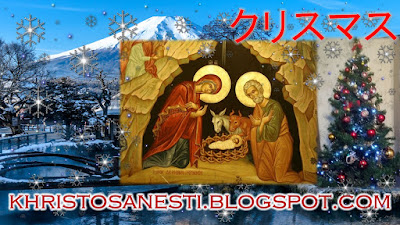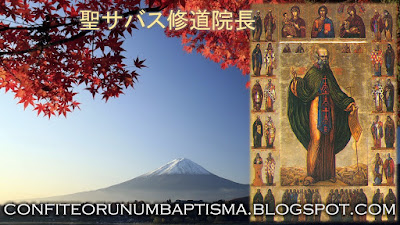ENGLISH:
December 7
Saint Ambrose, Bishop of Milan and Doctor of the Church
(340-397)
When in the year 369 Saint Ambrose, the young son of a Roman Senator, was sent by Probus, the Prefect of Italy, to the large province of Liguria Emilia in Italy, the officer said to him, Go and act not as a judge, but as a bishop. Ambrose, though not Christian, had already resisted by his probity the corrupting influence of the Roman youth of his day. In Liguria he showed himself to be clement as directed, and his great erudition also became well known to the inhabitants of the region. In the year 374 he was already governor of the province, at the moment when at Milan, in this same region, a bishop was needed for that great see. Since the heretics in Milan were many and fierce, he went to preserve order during the election of the new prelate. Though he was still only a catechumen, it was the Will of God that the provincial governor be chosen by acclamation. Despite his protestations and his subsequent flight from Milan when they were not accepted, he was found, baptized and consecrated for the archiepiscopal see.
Unwearied then in every pastoral duty, full of sympathy and charity, gentle and condescending in matters of indifference, he was inflexible in questions of principle. He manifested his fearless zeal when it was necessary to brave the anger of the Empress Justina, by resisting and foiling her impious attempt to give one of the churches of Milan to the Arians. He distributed all that he had of gold and silver to the poor, and confided all financial administration of his archdiocese to his brother, Saint Satyrus, who came to reside with him in Milan. To master theology, he studied the Sacred Scriptures and the Fathers of the Church, and conferred with learned Christians concerning the rules of ecclesiastical discipline. He was very active, and took such great care of the catechumens' instruction that no one could surpass him in that duty.
His zeal in rebuking and bringing to penance the great Emperor Theodosius, who in a moment of irritation had cruelly punished a sedition by the inhabitants of Thessalonica, is a well known fact of history. The Saint met him at the door of the cathedral to prevent his entering, and said to him that if he had imitated David in his crime, he must now imitate him in his penance. Later the chastened and humble Emperor said that in his life he had known but one true bishop — Ambrose.
Saint Ambrose was the friend and consoler of Saint Monica in all her sorrows, and in 387 had the joy of admitting to the Church Saint Augustine, her son. He died in 397, full of years and of honors, and is revered by the Church of God as one of her greatest Doctors.
Reflection: Whence came to Saint Ambrose his grandeur of mind, his clearness of insight, his intrepidity in maintaining the faith and discipline of the Church? Whence, if not from his contempt of the world and his fear of God alone?
------------------------------------------------------------------------------------
ESPAÑOL:
7 de diciembre
San Ambrosio, Obispo y doctor de la Iglesia
(333-397)
Era una familia feliz en todos los sentidos la de Ambrosio. Su padre, muy buena persona "hombre grande delante de Jesucristo y a los ojos del César", dirá su hijo. Su madre, una buena educadora. Su hermana Marcelina, que se entregará como virgen al servicio del Señor, y su hermano Sátiro, que ayudaba a su madre en la administración de su casa. El más pequeño, Ambrosio, que roba el cariño de todos por las extraordinarias cualidades que en él ya van apareciendo. Nació en Tréveris, donde su padre ejercía el alto cargo de prefecto.
Su padre espera que su hijo Ambrosio sea un gran militar que le supere a él. Por ello deberá estudiar derecho para que sepa las leyes y las haga cumplir.
Poco después llega la prueba a aquel hogar. Muere su padre. Su madre se traslada con sus hijos a Roma, la capital del imperio. Ambrosio tiene catorce años. Siempre recordará aquellos años de su niñez y adolescencia donde admiraba las maravillas de la naturaleza y la seriedad y cabal honradez de su buen padre.
A la edad de unos treinta años Ambrosio fue elegido gobernador de las provincias de Liguria y Emilia en nombre del emperador Valentiniano I. La Capital era Milán. Aquí desarrolló una gran labor este honrado Gobernador repartiendo justicia donde era necesario, sin importarle para nada las cualidades de las personas o su posición social. El prepotente Probo, de cuya gran amistad gozaba, cuenta que al despedirlo hacia su nuevo cargo, le dijo: "Ve, hijo mío, y condúcete no como juez, sino como obispo". Fue todo un vaticinio.
El obispo Auxencio había caído en la herejía arriana y había provocado una de las contiendas más duras de la época. La cosa estaba revuelta. Cristianos y arrianos se habían dado cita en la Basílica de Milán para dirimir la verdad y elegir el sucesor de aquel obispo que había dejado tan mal sabor de boca. Para calmar los ánimos demasiado encendidos, habló el Gobernador que creyó era allí necesaria su presencia para poner orden. Y aquí vino el prodigio. Todos quedaron hondamente impresionados por la sabiduría y verdad de cuanto salía de su boca. Parecía era todo Palabra del Espíritu Santo. Y un niño gritó: "¡Ambrosio es nuestro Obispo! ¡Ambrosio es nuestro Obispo!". Hubo un silencio sepulcral.
Todos quedaron admirados. Era la voz de Dios y todos la acataron gustosos, tanto cristianos como herejes. La voz de Dios manifestada por boca de aquel infante. Todos de acuerdo menos el protagonista, Ambrosio, que de ninguna forma quería aceptar. Él era aún un catecúmeno. Era el 7 de Diciembre del año 374. Este día quedará grabado en los fastos de la historia de la Iglesia como un día de fiesta, ya que de allí saldrá una de las cuatro grandes lumbreras o Doctores de Occidente. Ambrosio no pudo salir con la suya, ya que veía tan clara la voluntad de Dios manifestada por el deseo del pueblo.
Ambrosio empezó entregando todos sus bienes a los pobres. En una semana recibió el bautismo, las órdenes menores, el sacerdocio y el episcopado. Trató de formarse bien en la Teología católica de la que después escribirá profundos tratados de tan rica doctrina, en cuanto trata, que difícilmente se le puede superar. Su acción como Pastor y Padre fue inigualable. Reformó el clero de su tiempo que tanta necesidad tenía de ello: "Es necesario que en el sacerdote no haya nada vulgar, nada común, nada plebeyo, nada mundano". Y sabrá defender los derechos de la Iglesia contra los Príncipes que intenten denigrarla. Dirá al prefecto Calógono: "Si tú sabes obrar como cortesano injusto, yo sabré sufrir como obispo católico".
San Basilio le escribía: "No conozco tu rostro, pero la belleza de tu alma está delante de mis ojos... Dios te ha escogido para una obra eminente". "No temo morir, dijo, pues tenemos un Dios muy bueno". Era el 397 cuando le llegó la hora.
+++





